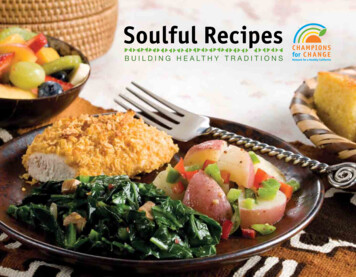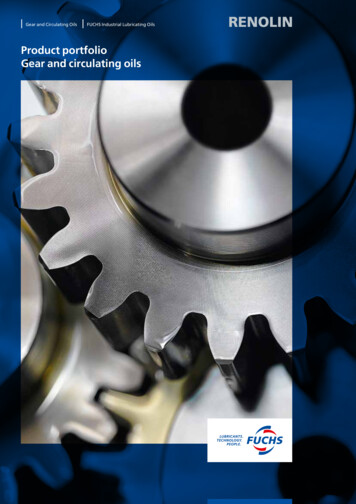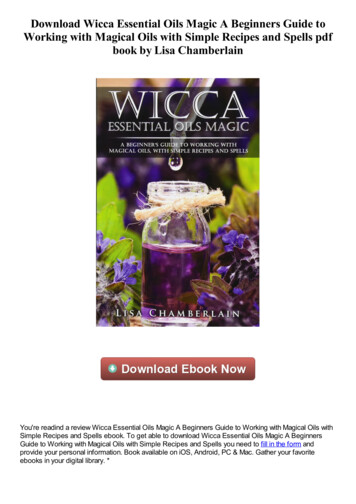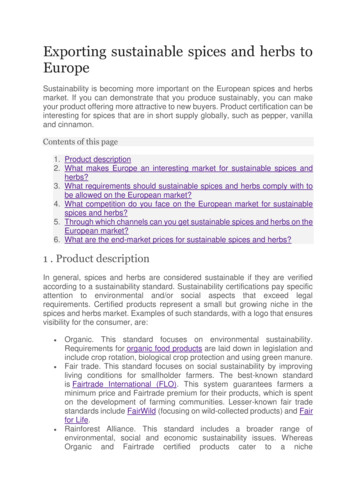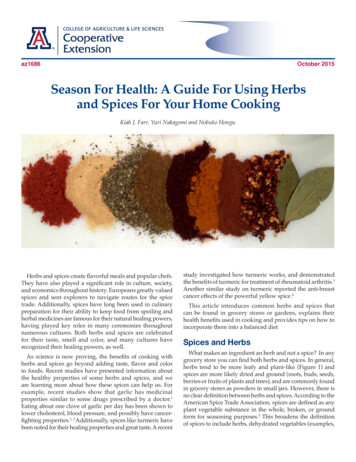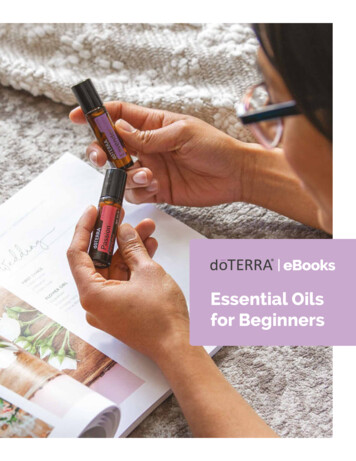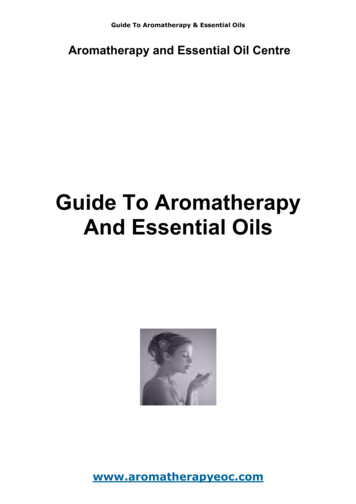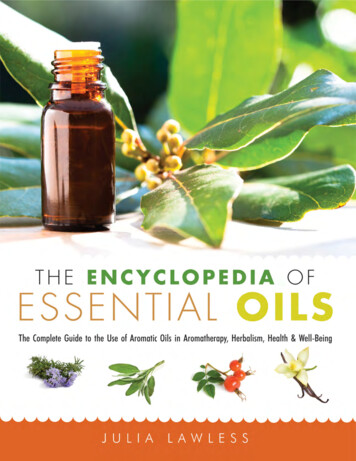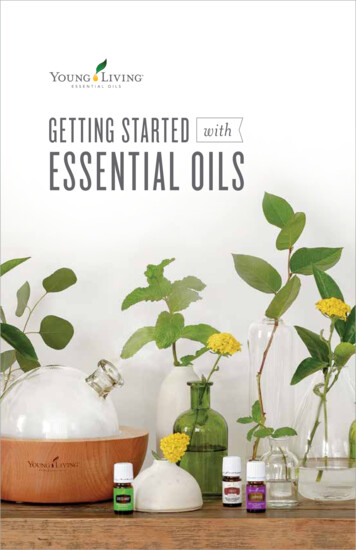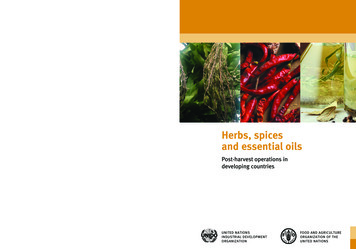
Transcription
Printed in AustriaV.05-91153—March 2006—300Herbs, spicesand essential oilsPost-harvest operations indeveloping countriesUNITED NATIONS INDUSTRIAL DEVELOPMENT ORGANIZATIONVienna International Centre, P.O. Box 300, 1400 Vienna, AustriaTelephone: ( 43-1) 26026-0, Fax: ( 43-1) 26926-69E-mail: unido@unido.org, Internet: http://www.unido.orgUNITED NATIONSINDUSTRIAL DEVELOPMENTORGANIZATIONFOOD AND AGRICULTUREORGANIZATION OF THEUNITED NATIONS
UNIDO and FAO 2005 — First published 2005All rights reserved. Reproduction and dissemination of material in this information product foreducational or other non-commercial purposes are authorized without any prior written permissionfrom the copyright holders provided the source is fully acknowledged. Reproduction of material inthis information product for resale or other commercial purposes is prohibited without writtenpermission of the copyright holders. Applications for such permission should be addressed to:-the Director, Agro-Industries and Sectoral Support Branch, UNIDO, Vienna InternationalCentre, P.O. Box 300, 1400 Vienna, Austria or by e-mail to unido@unido.org-the Chief, Publishing Management Service, Information Division, FAO, Viale delle Terme diCaracalla, 00100 Rome, Italy or by e-mail to copyright@fao.orgThe designations employed and the presentation of material in this information product do not implythe expression of any opinion whatsoever on the part of the United Nations Industrial DevelopmentOrganization or of the Food and Agriculture Organization of the United Nations concerning the legalor development status of any country, territory, city or area or of its authorities, or concerning thedelimitation of its frontiers or boundaries.The views expressed in this publication are those of the authors and do not necessarily reflect theviews of the United Nations Industrial Development Organization and of the Food and AgricultureOrganization of the United Nations.The mention or omission of specific companies, their products, or brand names does not imply anyendorsement or judgement by the United Nations Industrial Development Organization or by theFood and Agriculture Organization of the United Nations.This publication has not been formally edited.Thumbnail images of spices were taken from http://www.indianspices.com/html/s2100lst.htm, forwhich permission has been sought by the authors.ii
PREFACEThere is a continuing and expanding international demand for herbs, spices and essentialoils. Social changes, including food diversification, the desire for new flavours, increasingimportance of “ethnic” food and the increased importance of processed food, whichrequires condiments and aromatic herbs for its preparation, are driving an increase in thisdemand. Developing countries have a significant opportunity to benefit from this increasingdemand. Many of the products can be sold in a dried form or as extracts (e.g. essentialoils), which gives them a high value per unit weight. These products could be a profitablesource of diversification for small farmers in developing countries.It is in this connection that FAO and UNIDO decided to support this publication to giveextension services and small-scale producers basic information on processing herbs andspices in view of increasing the awareness on this area of industry and improving thequality and marketability of these products.Spices and condiments are defined as “Vegetable products or mixtures, free fromextraneous matter, used for flavouring, seasoning or imparting aroma in foods.” Herbs area subset of spices, generally derived from fresh or dried leaves, but in this guide nodistinction is made between spices and herbs, in keeping with the International StandardsOrganization (ISO) definition. Essential oils or extracts are also derived from these plantsources either as a primary processing or a secondary opportunity.This guide is a broad introduction to generic post-harvest operations, which are often thelimiting factors in the establishment of a profitable production enterprise based aroundherbs, spices and essential oils in developing countries. It is not intended to replacespecialist and specific crop advice in production and post harvest processing which isavailable in publications and from experts.This guide was prepared by M. Douglas, J. Heyes and B. Smallfield of the New ZealandInstitute for Crop and Food Research Inc. assisted with revisions by F. Mazaud (FAO) andC. Jenane (UNIDO). Special thanks to Ms. E. Jaklitsch, Ms. G. Garcia Nieto and Ms. V.Durand-Vuaille for the final editing and lay out of the guide.iii
iv
Prefaceiii1Introduction12Major spice crops in world trade13Economic Impact and Trade54Products84.1Primary products. 84.2Secondary and Derived Products . 94.3Requirements for Export and Quality Assurance . 94.4Consumer Preferences . 115Post-Production Operations5.111Pre-harvest Operations . 125.2 Harvesting. 135.2.1Harvesting Seeds and Fruits . 135.2.2Harvesting Leaves and Stems. 155.2.3Harvesting Flowers and Buds. 155.2.4Harvesting Roots and Rhizomes . 165.2.5Harvesting Bark, Wood, and Resins. 165.3Transport. 165.4Threshing . 175.5 Drying . 175.5.1Drying Seeds and Fruits . 195.5.2Drying Leaves and Stems . 215.5.3Drying Flowers and Buds . 215.5.4Drying Roots and Rhizomes. 225.6Cleaning. 225.7 Packaging . 235.7.1Packaging for Seeds and fruits. 235.7.2Packaging for Leaves and stems . 245.7.3Packaging for Flowers and buds . 245.7.4Packaging for Roots and Rhizomes . 245.7.5Packaging for Bark, Wood, and resins . 245.8Storage . 245.9 Processing . 255.9.1Grinding and separating . 255.9.2Extraction of essential oils . 266Overall Losses33v
7Pest control7.1Pest species . 337.2Relative status of major pest species . 347.3Pest control methods . 348933Economic and Social Considerations358.1Overview of costs and losses . 358.2Majors problems: Maintenance of Quality Standards . 358.3Proposed improvements . 358.4Gender aspects . 36References37Appendix I: Spice and Essential Oil Products and their GrowingRegions38Appendix II: Trade in Spices and Essential Oils53Appendix III: Quality Assurance and Standards57vi
1IntroductionSpices are used for flavour, colour, aroma and preservation of food or beverages. Spicesmay be derived from many parts of the plant: bark, buds, flowers, fruits, leaves, rhizomes,roots, seeds, stigmas and styles or the entire plant tops. The term ‘herb’ is used as asubset of spice and refers to plants with aromatic leaves. Spices are often dried and usedin a processed but complete state. Another option is to prepare extracts such as essentialoils by distilling the raw spice material (wet or dry), or to use solvents to extract oleoresinsand other standardized products. There are many texts which provide an overview of theindustry in general [1], [2], [3], [4] or for specific crops, [5-7].Essential oils are liquid products of steam or water distillation of plant parts (leaves, stems,bark, seeds, fruits, roots and plant exudates). Expression is used exclusively for theextraction of citrus oil from the fruit peel, because the chemical components of the oil areeasily damaged by heat. Citrus oil production is now a major by-product process of thejuice industry. An essential oil may contain up to several hundred chemical compoundsand this complex mixture of compounds gives the oil its characteristic fragrance andflavour. An essential oil may also be fractioned and sold as individual natural components.Other processing options can also produce further products that can be sold alongsideessential oils. The plant parts can be extracted with organic solvents to produceoleoresins, concretes and absolutes or extracted with a near or supercritical solvent suchas carbon dioxide to produce very high quality extracts. These oleoresins and extractscontain not only the volatile essential oil but also the concentrated non-volatile flavourcomponents and these have wide application in the food and pharmaceutical industries.The solvent extraction processes are more difficult and complex than steam distillation andwill normally be beyond the financial resources of most small scale processors, butsupplying the raw materials to these extraction plants can be a market option.The most important spices traditionally traded throughout the world are products of tropicalenvironments. The major exceptions to this group are the capsicums (chilli peppers,paprika), and coriander which are grown over a much wider range of tropical and nontropical environments. Production of spices and essential oils in these wet and humidenvironments brings special difficulties for crop and product management. Drying the cropto ensure a stable stored product is of particular importance, and in wet humidenvironments this creates the need for efficient and effective drying systems.2 Major spice crops in world tradeIn terms of world trade value, the most important spice crops from the tropical regions arepepper, capsicums, nutmeg/mace, cardamom, allspice/pimento, vanilla, cloves, ginger,cinnamon and cassia, and turmeric. Coriander, cumin, mustard, and sesame seeds andthe herbs sage, oregano, thyme, bay and the mints are the most important spice cropsfrom non-tropical environments. The characteristics and environmental needs of the cropsdominating the global spice trade are described below.PepperPepper (Piper nigrum) is a perennial vine, which produces a smallberry fruit, which is dried to become pepper. Pepper is a plant of thehumid tropics requiring adequate rainfall and warmth for its growth. Itis grown successfully between latitudes of 20 North and 20 Southand from sea level up to an altitude of 2400m. The crop can tolerate atemperature range between 10 and 40 C but the optimum is between25 C-40 C. A well-distributed rainfall in the range of 1250mm2000mm is considered necessary for pepper production.1
Capsicums, Chilli peppers and PaprikaCapsicums (Capsicum annuum var. annuum; C. chinense; C.frutescens) are the dried and processed fruit of these annual peppers.A rainfall of 600-1250mm is desirable. Rainfall is needed over thegrowing season but is not needed as the fruits ripen. Heavy rain duringflowering adversely affects pollination and wetness at ripeningencourages fungal spoilage. Capsicums flourish in warm sunnyconditions, require 3-5 months with a temperature range of 18 C-30 C;below 5 C growth is retarded, and frost kills plants at any growth stage.A seedbed temperature of 20-28 C is the optimum for germination.Nutmeg, Mace and By-productsThe perennial nutmeg tree (Myristica fragrans) growsto a height of 20m. Nutmeg is the kernel of the seed,while mace is the net like crimson coloured leatheryouter growth (aril) covering the shell of the seed. Thetree requires an optimal growing temperature between20-30 C and the annual rainfall should be between1500-2500mm.CardamomCardamom (Elettaria cardamomum; E. major; E. speciosa) is a tallgrowing ( 5m) perennial herb and the fruit, borne on panicles at thebase of the plants, is a trilocular capsule that contains 15-20 seeds.The natural altitudinal growing range is between 750-1500m while themost productive cultivated zone is between 1000 and 1200m. Theannual rainfall is usually 2500-4000mm in the monsoon belt. Atemperature range of 10-35 C occurs over the production areas with alower limit of about 17 C and an optimum temperature between 2224 C favoured. Cardamom grows naturally in shade but will producegood yields in only partial shade if well watered.Allspice – PimentoAllspice (Pimenta dioica) is a forest tree cultivated to produce the driedfruit berries which are the product allspice. It grows in semi-tropicallowland forests with a mean temperature of 18-24 C and an annualrainfall of 1500-1750mm. Evenly spread rainfall is desirable but treeswill grow well with rainfall between 1200-2500mm.VanillaVanilla (Vanilla planifolia, Mexican vanilla); V. pompona (West Indianvanilla); V. tahitensis (Tahitian vanilla) are perennial vines whichproduce vanilla beans. Vanilla grows well in humid tropical climateswith a well-distributed annual rainfall of 1900 – 2300mm but with noprolonged dry period. A warm humid climate with temperaturesranging between 24 C-30 C is preferred with a mean close to 27 C.2
ClovesThe clove tree (Syzygium aromaticum) is an evergreen which grows upto 15m in height. The clove tree produces buds which are used whole orground as a spice. Bud and stem oils and oleoresins, and leaf oil, areused principally as a source of eugenol. An optimal rainfall is 17502500mm, with a dry season and a temperature range of 15-30 C in amaritime environment.GingerGinger (Zingiber officinale) rhizome is the source of the most importantginger products which are dried rhizome, whole or ground as spice withginger oil and oleoresins used as flavourings. A well-distributed yearlyrainfall of 2500-3000mm is the optimum with a minimum rainfall of1500mm. The crop flourishes under warm sunny conditions but daytemperatures above 30 C can cause leaf scorching while temperaturesabove 37 C without humidity and water can cause plant death. Groundtemperatures of 25-30 C are optimum for initial rhizome growth. Frostwill kill the foliage and rhizomes near the surface but altitude as such isnot a constraint to ginger production.Cinnamon and CassiaCinnamon and cassia spices (Cinnamomum verum; Cinnamomumcassia (China); C. burmannii (Indonesia), and C. loureirii (Vietnam), arethe prepared dried bark of the trees belonging to the genusCinnamomum. Cinnamon is the hardiest among the tree spices,tolerating a wide range of soil and climatic conditions. The optimumclimate has an average temperature between 27-30 C and 20002500mm of rainfall. Cinnamon is an evergreen tree that is kept to aheight of 2-3m. The soil conditions are very important, as waterloggedsoil will produce a bitter cinnamon bark.TurmericTurmeric (Curcuma longa) is a plant of open forests with partial orintermittent shade desirable, although recent research has shown cropyields can be higher in open cultivation. An annual rainfall between1000-2000mm is necessary with 1500mm being optimum. Adequatesoil moisture is the most significant factor affecting rhizome yield, thetarget product. Temperature is important, as the optimum varies withcrop growth. High heat (30-35 C) is needed to encourage sprouting, 2530 C during tillering, 20-25 C as rhizomes appear and 18-20 C duringenlargement.The major spice crops outside the tropical environments are the flower stigma of saffron,the fruits (“seeds”) of coriander and cumin, seed of mustard and sesame, and the leaves ofbay, sage, origanum and thyme.3
SaffronSaffron (Crocus sativus) is a sterile hybrid and re-propagates annuallyby producing replacement daughter corms. The dried tri-lobed stigma ofthe saffron crocus flower is the commercial product. The autumnflowering saffron grows best in Mediterranean environments with coolmoist winters and hot dry summers, and under this type of environmentstrategic irrigation will aid flower production.CorianderCoriander (Coriandrum sativum) is a strong smelling annual herbextensively grown in many climates throughout the world. In commerce,coriander is broadly divided into two types according to the size of thefruit, which in turn determines the volatile oil content and end use. Thesmall fruited type var. microcarpum (diameter 1.5-3mm) is grown widelyin cooler temperate regions while the larger fruited type var. vulgare(diameter 3-5mm) is grown in tropical and subtropical environments.The small-fruited types contain higher oil (0.5-2%), which is extracted forits essential oil while the larger fruit with a lower oil ( 1%), is used forgrinding and blending. The fresh leaf (cilantro) is used in Asian cuisine.CuminCumin (Cuminum cyminum), a small annual herb native to theMediterranean region, which is grown for its aromatic dried fruit that iswidely used in cooking. Cumin prefers areas with low atmospherichumidity during the period of flowering, seed formation and ripening.Mustard seedWhite Mustard (Sinapis alba) and Indian mustard (pictured; Brassicajuncea) are annual or biennial herbs. They are cultivated world-wide fordried ripe seeds, and used extensively in prepared mustards or in foodproducts. The extracted mustard oil is also widely used as a foodflavour ingredient.Sesame seedSesame (Sesamum indicum), an annual herb, is now widely grownbetween 25 N and 25 S and can be grown to 40 N and 35 S. Sesameis grown for its seed in a wide range of environments from tropical totemperate and needs mean temperatures above 10 C and to 40 Cmaximum. The plant is killed by frost and, depending on cultivar,matures within 40 to 180 days.In addition to the major spice crops listed above is detailed in Appendix I, Tables 1-5, theclimatic range for 275 herb, spice and essential oil crops as per FAO website(http://ecocrop.fao.org). The Köppen biome classification for these growing regions isshown at: t/climate/EIsp0054.htm.4
3 Economic Impact and TradeThere are around 40 to 50 spices of global economic and culinary importance. There arealso many other species that are used in traditional cooking in the region of their naturaloccurrence but have yet to reach any significant trade [8]. The major spices ofinternational trade have well known stable long-term markets but most species tend to becommodities and as such there is competition and price fluctuations. The value of globalspice imports is estimated at US 2 to 2.4 billion and in 2002 pepper topped the list with20% of the total value followed by capsicum (18%), vanilla (13%), nutmeg/mace/cardamom(9%), spice seeds (8%) and ginger (6%). The major spice production is in the tropics fromdeveloping and least developed countries. There is also a very significant domesticconsumption of spices in many spice-producing countries. The supply side of the industryhas always been dynamic and has been punctuated by periodic relocations of the majorproduction areas. To remain competitive, countries such as India are moving into thevalue-added sector, producing spice, essential oils, oleoresins, powders, speciality extractsand blends. In addition, India has established spice Agri-Export Zones and they areactively developing capabilities in quality management, improved packaging andtechnology innovation in production and processing. The largest spice importer is theEuropean Union (with Germany being the leading country in the EU). The USA and Japanare the two largest single country importers of spices. In the EU countries, 55-60% of thetotal spice and herb use is for industrial consumption, 35-40% by the retail sector and 1015% by the catering sector. The high industrial sector use reflects the growing popularityof ready-to-use spice mixtures. Another reason is the increasing consumption ofprocessed foods and ready to eat dishes, which often rely on spices and herbs to retainand enhance food flavour.The ever more stringent regulations governing the international trade in spices and theirderivatives for culinary use in food processing will mean that spice producers who ignoresuch specifications will eventually lose their markets to quality producers. For example, theEU (European Union) has aflatoxin regulations to detect contaminated consignments andrestrict their import while adulteration of spices with colourants has led to product bans.Some two hundred essential oils are produced and traded internationally in volumes thatrange from 20-30,000 tonnes for orange oil to less than 100 kg for some specialty flowerextracts. Prices vary widely, but for the majority of oils traded in volume, they fall within therange of US 4- 60/kg and for specialist minor oils, the price can be many hundreds ofUS /kg. The citrus oils (orange, lemon, tangerine, lime, manadarin, grapefruit etc.) plusthe mint oils have by far the largest number of important applications in tonnages as wellas variety of flavours. The seasoning oils of spices and herbs (clove bud, coriander,cinnamon, garlic, nutmeg, onion etc) are traded in lesser quantities and have moreselected applications. The majority of other oils are used in even lower quantities and havemore targeted applications.Estimating world production and trade of essential oils is fraught with difficulties [9]. Inmany countries domestic production statistics are not recorded and export statistics arerecorded for some of the high volume oils and the rest are often included in codes thatencompass a range of products. Therefore publications of global production must betreated with a high degree of suspicion as they are based on limited statistical data from afew countries and generally ignore factors such as domestic consumption.Mature markets, where demand for essential oils is highly developed, have low potentialgrowth because of low population growth. The European Union is the world’s biggestimporter of essential oils (with France, Germany and UK being the major importingcountries). The USA is the world’s largest importing country of essential oils followed byJapan. Most of the oils go into mainstream industries and the number of mainstream userscontinues to decline through mergers and acquisitions. Aromatherapy is seen as apotential high value growth area; however, it represents less than 1-2% of the total5
essential oil trade. It is predicted that the growth in essential oils will be led by the flavouroils [10]. Use of essential oil for perfume and fragrance applications is predicted to reduce.Derivatives of dual–purpose and industrial oils will be imported from processing factorieslocated in oil producing countries rather than from imported oils.The growth markets for uses of essential oils are predicted to be in the rapidly developingcountries (dominated by China and India), Eastern Europe and Russia and less developedcountries. Long-term, the amounts consumed in these growing markets is predicted toexceed the current consumption of the industrialised countries. Demand is predicted to begreatest for low-value fragrance oils used in soaps, detergents and related products withsmaller growth in the flavour oils, mainly for non alcoholic beverages (citrus and spice oils)and oral care products (mint oils). A growth in use of flavour oils in the processed foodindustries will be confined mainly to developing countries with growing middle classpopulations.The trade distribution structure in the spice and herb trade can be divided into lines ofsupply to the three broad market sectors – industrial, catering and retail (Figure 1). Thestructure of the supply tree shows there are a number different routes to market, and themost direct is the producer supplying directly to the industrial sector. It is estimated thatabout 85% of the international trade of herbs and spices is dried and cleaned for use in acrude form without further processing.Spice and Herb ProducersExporter/shipperAgent/BrokerTrader/ ImporterRe-ExportGrinder/Processor/PackerWhole sale sectorRetail sectorSupermarketGrocery,DelicatessenCatering nstitutionsIndustrial SectorFood &BeverageProcessingMedicinalOtherFigure 1: Trade distribution structure for spices and spice products.The world trade for the major spice products shows that pepper is the most valuable spicein the global trade, with capsicum trade rising to higher annual tonnage but lesser value(Appendix II, Table 6).The top three exporting countries for specific spices or groups of spices show the leadingproducing countries are in tropical environments, while countries in summer dryMediterranean or continental environments are the major producers of spice fruits andseeds, saffron, thyme and bay leaves (Appendix II, Table 7). The major spice tradingcountries are China, Madagascar, Indonesia and India while Guatemala, Brazil, Vietnamand Sri Lanka are significant traders. The value of that trade varies annually, andfluctuates about US2.5 billion (Appendix II, Table 8).6
Closely linked to the spice and herb trade is the extraction of flavour and aromacompounds in essential oils. The trade distribution for essential oils and oleoresins canalso have a number of routes to market. The most simple is the small oil producer sellingto the local market or to tourists while the large-scale producers would normally dealthrough fragrance and flavour house formulators. There are many manufacturingindustries where the extracts of spices, herbs, and aromatic resins are used for flavour,aroma or product formulation (Figure 2).Small producerWild plant gathersgatherersLocal collectorProcessorLarge Scale producersFlavour & Fragrance HouseCo-operativeProcessingPrimary Processingin country of originEssential oilsas by -products(eg Juice & spiceindustries)Trader & ExporterBrokerTrader, Importer and ExporterAgentFlavour and Fragrance HouseFormulatorsAgentNiche TourismorLocal marketsCosmetic andpersonalHouseholdproductFood nufacturesWholesale networkRetail networkConsumerFigure 2: Trade distribution structure for essential oils and oleoresins.The steam distilled essential oils or solvent-soluble oleoresins are primarily extracted fromthe herbs and spices in their raw form, but other plant parts such as leaves or rhizomescan also be extracted. The production tree for essential oils shows there are four broadsectors – flavour industries, personal care, pharmaceutical and industrial (Figure 3).7
Essential OilsEssentialOilFlavour industriesFood & Beverages Flavouring Preservatives Confectionary DrinksPersonal CarePharmaceuticalMedicinal Anti bacterialCosmetics & Toiletries Perfume, colognes Antifungal Sprays DecongestantIndustrialPesticide Industry Sprays Repellents AttractantsMotor Industry Creams, powders Polishes, cleaners Soaps, shampoosVeterinary Deodorants PharmaceuticalsTobacco IndustryPaper & Print Flavouring Crayons, inksDental Fixatives Labels, wrappers, paper Toothpaste Mouth washPharmaceutical Flavouring AntisepticsRubber & Plastics Cements Deodorants Rubber and plasticsHouseholdTextile Industry Soaps & Detergents Deodorants Cleaners Upholstery materials Airfreshners Finishing materialsPaints & Adhesives Cements & Glues Paints, removes Cleaners & AirfreshnersFigure 3: Industries and product categories that use essential oils.The traded quantities and values of essential oils (see Appendix II, Table 9) provide aperspective of the international trade, although, as noted, up to date collated data is notreadily available. It is also to be noted that extracts and oleoresins of spices which arebecoming much more common and extracted in the countries of crop production, are notdetailed within this data.4 Products4.1Primary productsThe primary products harvested for spice or essential oil production can be broadly dividedinto six categories: seeds and fruits, leaves and stems, flowers and buds, roots andrhizomes, and bark, wood and resins. Appendix I, Tables 1-5, separated by plant parts,details the most important spice and essential oil crops by species name, common name,family name and a broad description of the plant habit. In some cases, for example Pinus,the genus has been referred to but locally specific species have not been separated anddetailed. Appendix I also details the plant
An essential oil may contain up to several hundred chemical compounds and this complex mixture of compounds gives the oil its characteristic fragrance and flavour. An essential oil may also be fractioned and sold as individual natural components. Other processing options can also produce further products th
